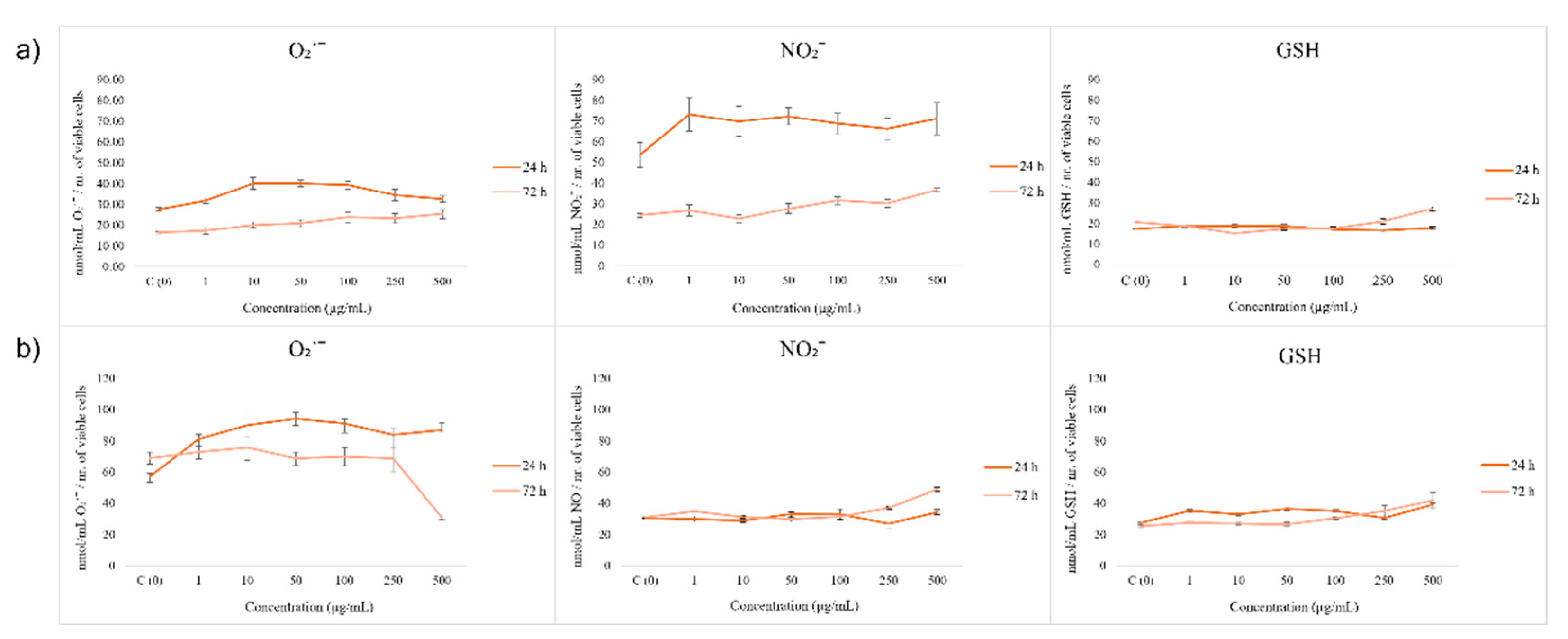Extract of Edible Mushroom Laetiporus sulphureus Affects the Redox Status and Motility of Colorectal and Cervical Cancer Cell Lines †
Abstract
:1. Introduction
2. Methods
3. Results and Discussion
4. Conclusions
Author Contributions
Funding
Institutional Review Board Statement
Informed Consent Statement
Data Availability Statement
Conflicts of Interest
References
- Florescu-Ţenea, R.M.; Kamal, A.M.; Mitruţ, P.; Mitruţ, R.; Ilie, D.S.; Nicolaescu, A.C.; Mogoantă, L. Colorectal cancer: An update on treatment options and future perspectives. Curr. Health Sci. J. 2019, 45, 134–141. [Google Scholar] [CrossRef]
- Ahmed, M. Colon cancer: A clinician’s perspective in 2019. Gastroenterol. Res. 2020, 13, 1–10. [Google Scholar] [CrossRef]
- Zhang, S.; Xu, H.; Zhang, L.; Qiao, Y. Cervical cancer: Epidemiology, risk factors and screening. Chin. J. Cancer Res. Chung-Kuo Yen Cheng Yen Chiu 2020, 32, 720–728. [Google Scholar] [CrossRef]
- Liou, G.Y.; Storz, P. Reactive oxygen species in cancer. Free Radic. Res. 2010, 44, 479–496. [Google Scholar] [CrossRef] [Green Version]
- Younis, A.M.; Yosric, M.; Stewarte, J.K. In vitro evaluation of pleiotropic properties of wild mushroom Laetiporus sulphureus. Ann. Agric. Sci. 2019, 64, 79–87. [Google Scholar] [CrossRef]
- Šeklić, D.S.; Stanković, M.S.; Milutinović, M.G.; Topuzović, M.D.; Štajn, A.Š.; Marković, S.D. Cytotoxic, antimigratory, pro-and antioxidative activities of extracts from medicinal mushrooms on colon cancer cell lines. Arch. Biol. Sci. 2016, 68, 93–105. [Google Scholar] [CrossRef]
- Kosanić, M.; Šeklić, D.S.; Jovanović, M.M.; Petrović, N.; Marković, S. Original article—Hygrophorus eburneus, edible mushroom, a promising natural bioactive agent. EXCLI J. 2020, 19, 442–457. [Google Scholar] [PubMed]
- Hassen, S.; Ali, A.A.; Kilaparty, S.P.; Al-Anbaky, Q.Q.; Majeed, W.; Boman, B.M.; Fields, J.Z.; Ali, N. Interdependence of DNA mismatch repair proteins MLH1 and MSH2 in apoptosis in human colorectal carcinoma cell lines. Mol. Cell. Biochem. 2016, 412, 297–305. [Google Scholar] [CrossRef] [PubMed]
- Fini, M.A.; Orchard-Webb, D.; Kosmider, B.; Amon, J.D.; Kelland, R.; Shibao, G.; Wright, R.M. Migratory activity of human breast cancer cells is modulated by differential expression of xanthine oxidoreductase. J. Cell Biochem. 2008, 105, 1008–1026. [Google Scholar] [CrossRef] [PubMed] [Green Version]
- Nishikawa, M. Reactive oxygen species in tumor metastasis. Cancer Lett. 2008, 266, 53–59. [Google Scholar] [CrossRef] [PubMed]



Publisher’s Note: MDPI stays neutral with regard to jurisdictional claims in published maps and institutional affiliations. |
© 2021 by the authors. Licensee MDPI, Basel, Switzerland. This article is an open access article distributed under the terms and conditions of the Creative Commons Attribution (CC BY) license (https://creativecommons.org/licenses/by/4.0/).
Share and Cite
Jovanović, M.M.; Virijević, K.; Grujić, J.; Živanović, M.; Šeklić, D.S. Extract of Edible Mushroom Laetiporus sulphureus Affects the Redox Status and Motility of Colorectal and Cervical Cancer Cell Lines. Biol. Life Sci. Forum 2021, 6, 82. https://doi.org/10.3390/Foods2021-11028
Jovanović MM, Virijević K, Grujić J, Živanović M, Šeklić DS. Extract of Edible Mushroom Laetiporus sulphureus Affects the Redox Status and Motility of Colorectal and Cervical Cancer Cell Lines. Biology and Life Sciences Forum. 2021; 6(1):82. https://doi.org/10.3390/Foods2021-11028
Chicago/Turabian StyleJovanović, Milena M., Katarina Virijević, Jelena Grujić, Marko Živanović, and Dragana S. Šeklić. 2021. "Extract of Edible Mushroom Laetiporus sulphureus Affects the Redox Status and Motility of Colorectal and Cervical Cancer Cell Lines" Biology and Life Sciences Forum 6, no. 1: 82. https://doi.org/10.3390/Foods2021-11028
APA StyleJovanović, M. M., Virijević, K., Grujić, J., Živanović, M., & Šeklić, D. S. (2021). Extract of Edible Mushroom Laetiporus sulphureus Affects the Redox Status and Motility of Colorectal and Cervical Cancer Cell Lines. Biology and Life Sciences Forum, 6(1), 82. https://doi.org/10.3390/Foods2021-11028






